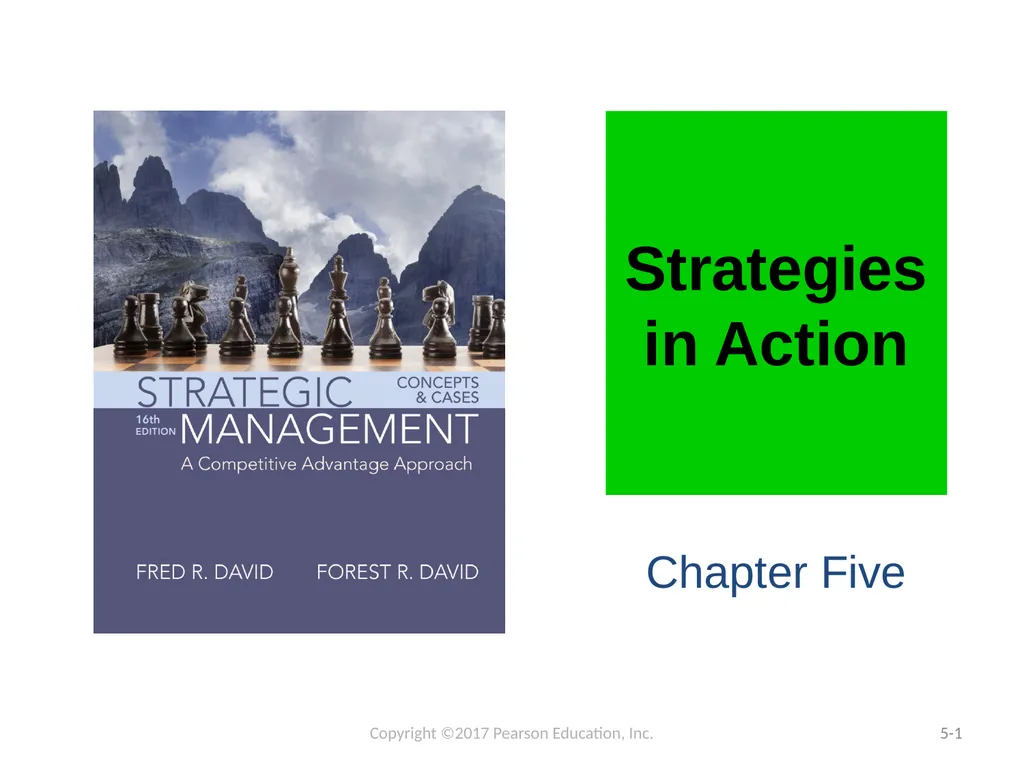Strategies in Action Chapter Five Copyright ©2017
Author : tawny-fly | Published Date : 2025-11-01
Description: Strategies in Action Chapter Five Copyright 2017 Pearson Education Inc 51 Learning Objectives Identify and discuss eight characteristics of objectives and ten benefits of having clear objectives Define and give an example of eleven
Presentation Embed Code
Download Presentation
Download
Presentation The PPT/PDF document
"Strategies in Action Chapter Five Copyright ©2017" is the property of its rightful owner.
Permission is granted to download and print the materials on this website for personal, non-commercial use only,
and to display it on your personal computer provided you do not modify the materials and that you retain all
copyright notices contained in the materials. By downloading content from our website, you accept the terms of
this agreement.
Transcript:Strategies in Action Chapter Five Copyright ©2017:
Strategies in Action Chapter Five Copyright ©2017 Pearson Education, Inc. 5-1 Learning Objectives Identify and discuss eight characteristics of objectives and ten benefits of having clear objectives. Define and give an example of eleven types of strategies. Identify and discuss the three types of “Integration Strategies.” Give specific guidelines when market penetration, market development, and product development are especially effective strategies. Explain when diversification is an effective business strategy. Copyright ©2017 Pearson Education, Inc. 5-2 Learning Objectives (cont.) List guidelines for when retrenchment, divestiture, and liquidation are especially effective strategies. Identify and discuss Porter’s five generic strategies. Compare (a) cooperation among competitors, (b) joint venture and partnering, and (c) merger/acquisition as key means for achieving strategies. Discuss tactics to facilitate strategies, such as (a) being a first mover, (b) outsourcing, and (c) reshoring. Explain how strategic planning differs in for-profit, not-for-profit, and small firms. Copyright ©2017 Pearson Education, Inc. 5-3 Long-Term Objectives The results expected from pursuing certain strategies 2-to-5 year timeframe Copyright ©2017 Pearson Education, Inc. 5-4 Varying Performance Measures by Organizational Level Copyright ©2017 Pearson Education, Inc. 5-5 The Desired Characteristics of Objectives Copyright ©2017 Pearson Education, Inc. 5-6 The Nature of Long-Term Objectives Objectives provide direction allow synergy assist in evaluation establish priorities reduce uncertainty minimize conflicts stimulate exertion aid in both the allocation of resources and the design of jobs Copyright ©2017 Pearson Education, Inc. 5-7 Financial versus Strategic Objectives Financial objectives include growth in revenues, growth in earnings, higher dividends, larger profit margins, greater return on investment, higher earnings per share, a rising stock price, improved cash flow, and so on. Strategic objectives include a larger market share, quicker on-time delivery than rivals, shorter design-to-market times than rivals, lower costs than rivals, higher product quality than rivals, wider geographic coverage than rivals, achieving technological leadership, consistently getting new or improved products to market ahead of rivals, and so on. Copyright ©2017 Pearson Education, Inc. 5-8 Not Managing by Objectives Copyright ©2017 Pearson Education, Inc. 5-9 Copyright ©2017 Pearson Education, Inc. 5-10 A Comprehensive Strategic-Management Model Types of Strategies Most organizations simultaneously pursue a combination of two or more strategies, but a combination strategy can be exceptionally risky if carried too far. No organization can afford to pursue all the strategies that might benefit the firm. Difficult decisions must be made and priorities must be established. Copyright ©2017 Pearson Education, Inc. 5-11 Alternative Strategies Defined and










![[EBOOK] - Five Little Monkeys Reading in Bed (A Five Little Monkeys Story)](https://thumbs.docslides.com/882706/ebook-five-little-monkeys-reading-in-bed-a-five-little-monkeys-story.jpg)
![[DOWNLOAD] - Five Little Monkeys Bake a Birthday Cake (A Five Little Monkeys Story)](https://thumbs.docslides.com/890245/download-five-little-monkeys-bake-a-birthday-cake-a-five-little-monkeys-story.jpg)

